Herb Container Gardening: The Ultimate Guide To the Best Herbs To Use
Here are tips and ideas for planting, growing, and cultivating herbs in containers. Learn the best herbs to plant, an easy recipe using each herb, and how to freeze them.
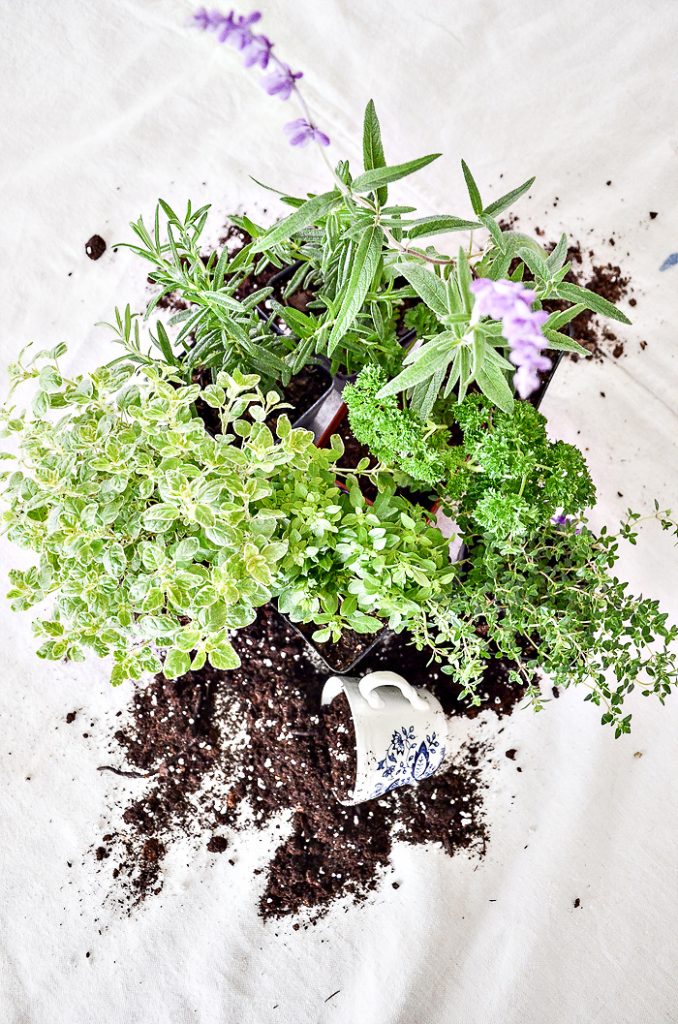
Herb container gardening is one of the best things about summer! I’ve been planting, clipping, and enjoying herbs grown in all kinds of containers for years and years. Herbs are easy to grow and have so many uses. Today, I’m sharing a huge guide with everything you will need to know about herbs in containers!
Affiliate links may be included at no additional cost to you. For more information, see our Discloser Policy. As an Amazon Associate, I earn from qualifying purchases.
You don’t need a garden to grow herbs. Even when I had a big garden, I still grew pots of herbs near my back door so I could easily go out and snip them for recipes, bouquets, and so many other uses.
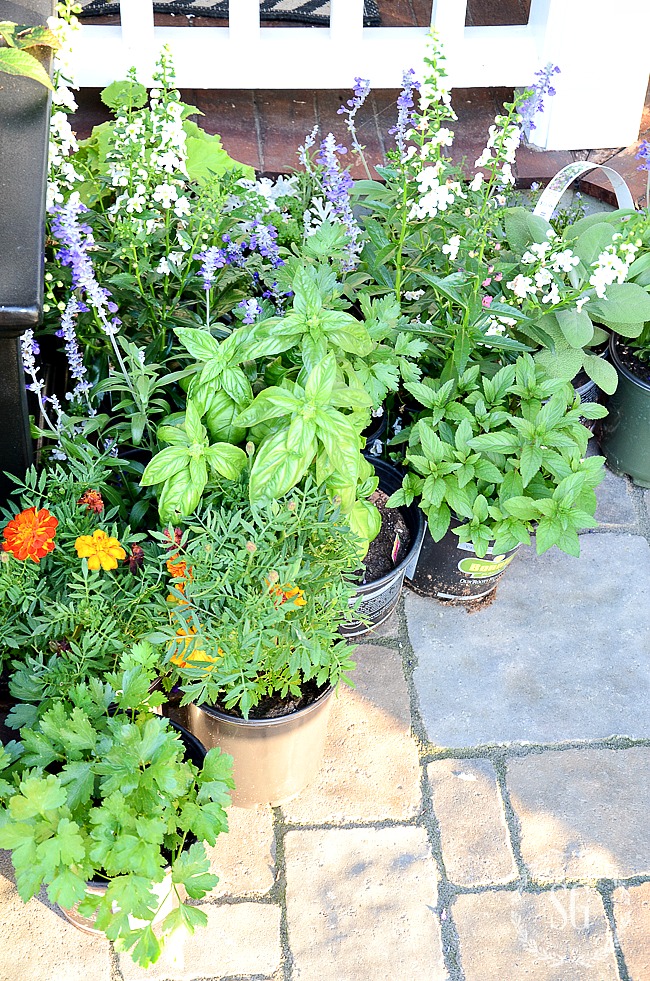
Basics Things To Know About Herb Container Gardening
Growing herbs in a container is quite easy because herbs are not demanding plants. A little tending yields a container filled with pretty aromatic plants that can be snipped often, used in the kitchen, and more!
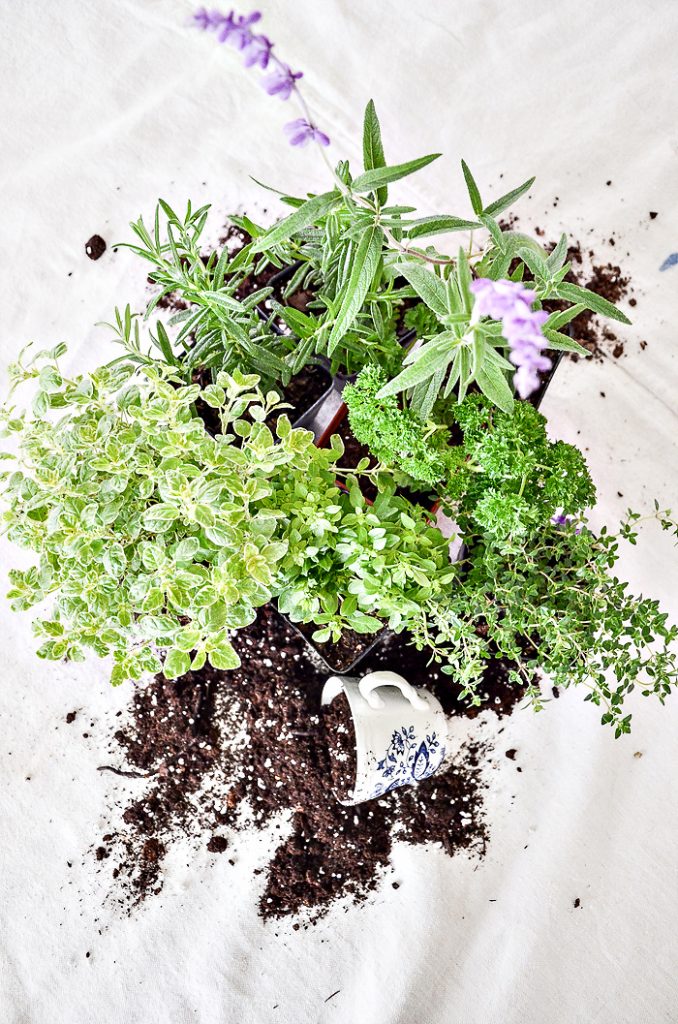
Here are things to know to help you grow a healthy herb garden!
- Use the proper container. Ensure there is enough room in a container for each plant to grow.
- The container should have drainage holes. I sometimes don’t follow this rule, but then I have to be very meticulous about watering the herbs!
- Plant herbs that like the same conditions together. Sometimes, I plant quite a few different varieties of herbs in a pot and see how they do. They are very forgiving and often thrive in non-optional conditions. Do as I say, not as I do!
- Transplant herbs when they get overcrowded. Easy-peasy! Give the divided herb plant away. People love them.
- Because I often plant a lot of herbs together in one pot, my watering rule of thumb is to give them a good soaking and let them get just a little dry before watering them again. But no droopy plants! That’s a sign your herb might need water.
- Feed herbs every month. Here is the HERB FOOD I am using.
- Most herbs are sun lovers. So, put a container garden in a sunny location.
- Snip and pinch and pick often! The more cut an herb, the more it grows.
- Many herbs can “winter over” if left in their pots. My chives, parsley, sage, peppermint and thyme returned bigger than ever this year.
- Annuals can be companion-planted alongside herbs in a container. Just make sure the needs of the flower you are considering are compatible with the herbs. I love the look of sweet alyssum mixed with herbs!
Most herbs are easy to grow and love being potted. Here are the 7 best and easiest herbs to grow in a container.

Best Tip: If you are going to eat herbs, buy those that have not been treated with pesticides.
Mint: My Favorite Herb
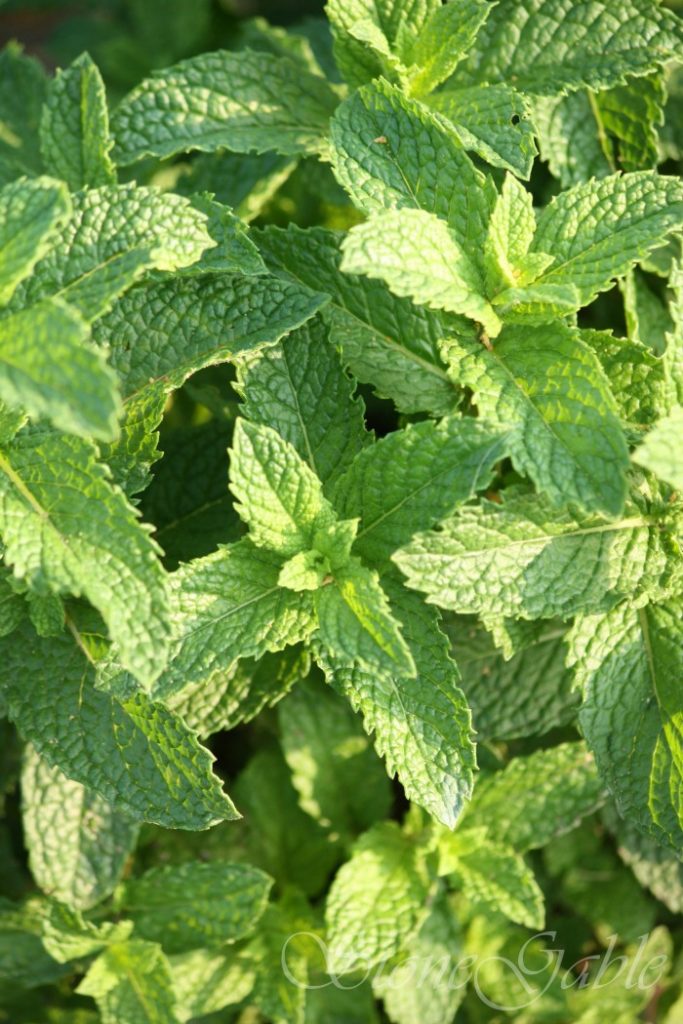
One of my fondest childhood memories is a fence-lined portion of my grandmother’s yard full of mint. The whole area smelled heavenly!
Mint is a must-have in a pot during the summer months! I use it to make mint tea and so so much more! It looks so pretty tucked in a bouquet of garden flowers, and its fresh scent is noticeable.
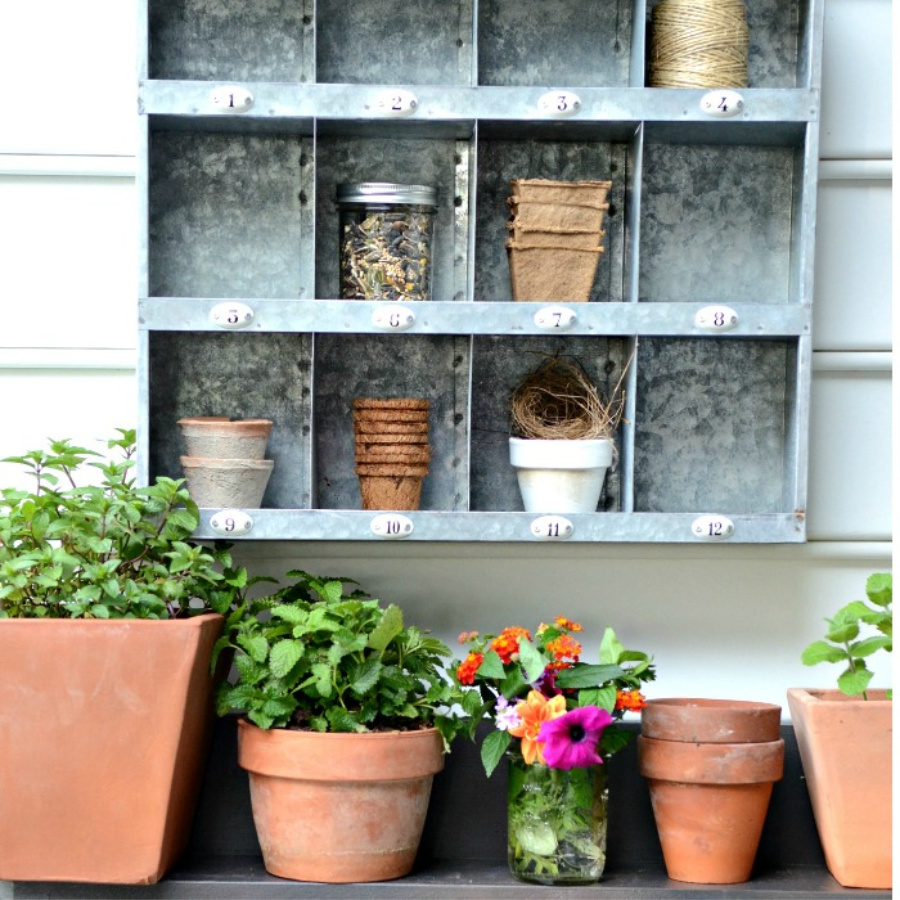
Mint Growing Ideas
Although mint is easy, actually super easy, to grow in containers, you should know a few things about this versatile plant…
- Grow mint in its own pot. It is so invasive that it does not play well with other herbs. Its roots will take over the entire container or garden bed.
- You need to monitor mint carefully. You will want to snip back the ends of the plant to encourage growth. Otherwise, it can get leggy.
- Mint is really a perennial. Don’t throw it away. It may come back in the pot next year!
- Mint loves the sun but can thrive in partial sun, too. It is a thirsty plant and likes damp soil.
- Mint comes in varieties like chocolate, apple, and pineapple. Give them a try.
This year, I am growing peppermint and spearmint.
Basil: The Most Delicious Summer Her
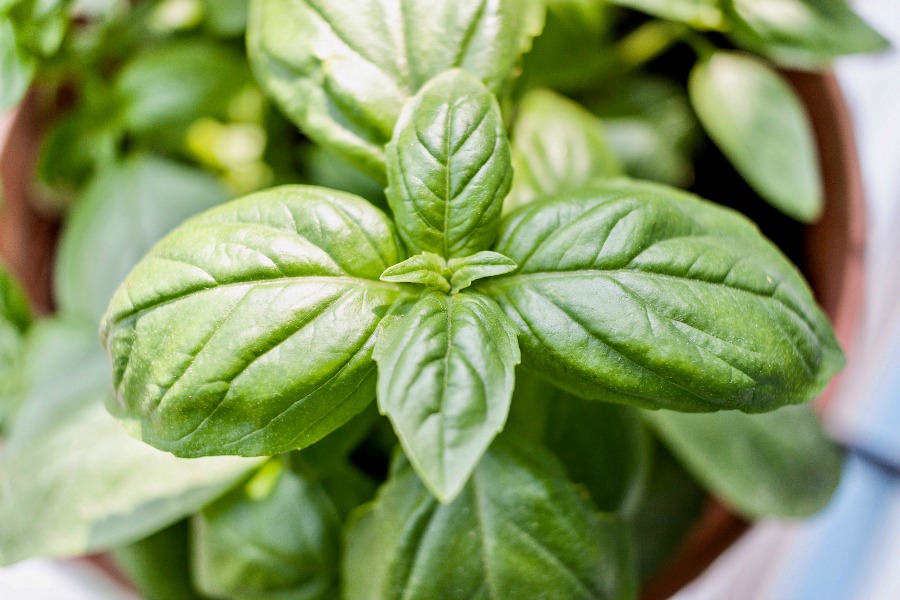
Basil is my go-to summer herb. Its iconic aroma reminds me of summer, and it is the perfect container garden herb. Believe it or not, basil is a member of the mint family!
We love pesto! We make big batches of this basil recipe and freeze it in ice cube trays. Then we can eat garden pesto all winter long! I could eat it by the spoonfuls, and so could the rest of our family.
I plant basil in its own pot, not because it does not get along with other herbs. No, it’s a happy fellow (or miss). I plant lots of basil! And a basil plant, given the chance, can grow quite large! So it is best grown by itself.
Basil Growing Ideas
Here are some things to know about basil…
- Basil needs heat to grow, and it does not like the cold. So don’t rush to plant it in the spring. Wait until around Memorial Day.
- Basil likes the sun. Keep it in a sunny location with at least 6 hours of sun a day, and it will repay you with lots of gorgeous, aromatic leaves!
- Don’t let the basil dry out. If it gets too dry, the leaves will quickly wilt. A good watering usually revives them.
- Pinch off the center shoots of the plant (and use them) so the plant doesn’t flower and get bitter.
- Prune basil aggressively to promote new growth.
I plant sweet basil and a miniature dwarf Greek basil variety that can be trained into a topiary. There are so many different kinds of basil to explore!
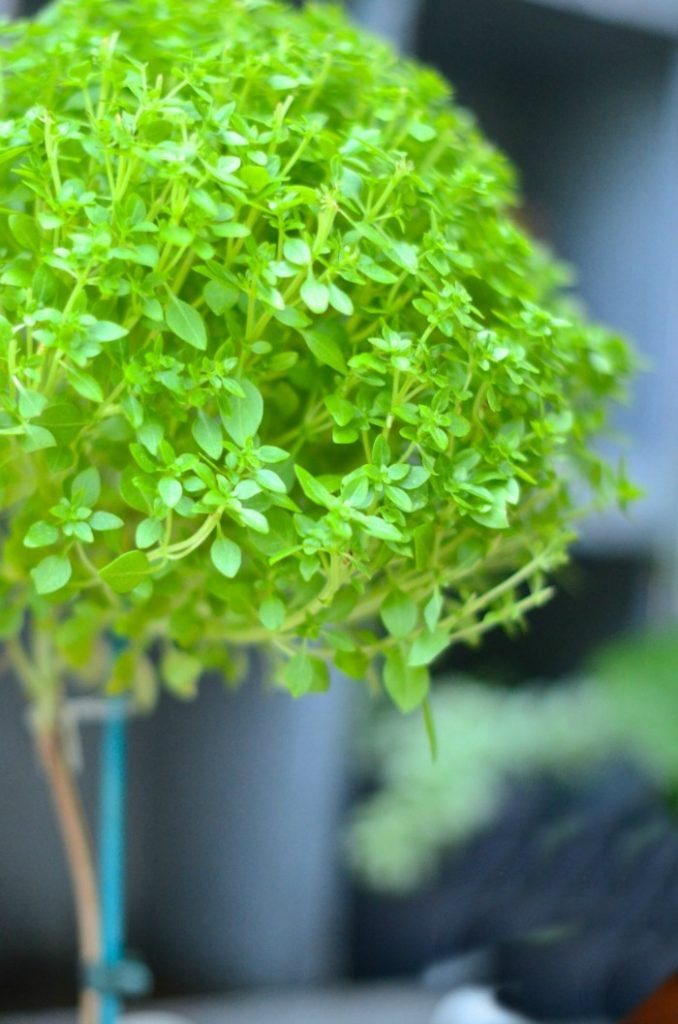
Plant Thyme
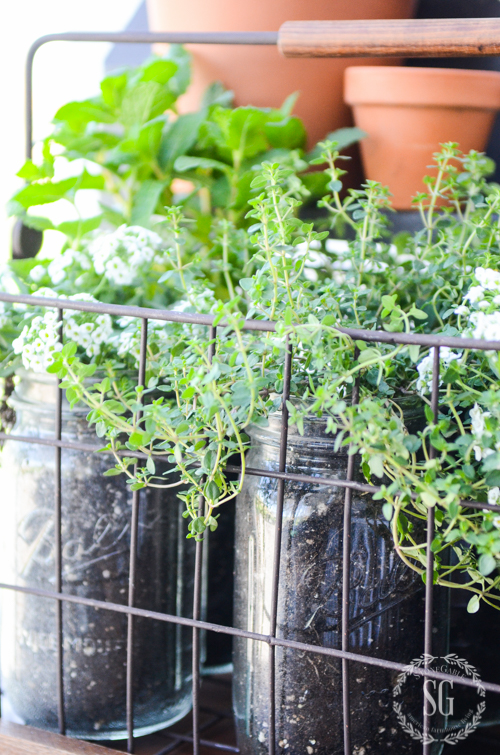
Thyme is such a friendly herb! It plays so well with other herbs in and out of the garden. Mint must have a large family because thyme is a member!
It is the perfect container garden herb! It’s pretty and fluffy and loves to be planted with other herbs.
I cook with thyme and use it as a garnish, and it looks so attractive in a garden flower bouquet.
Things To Know About Thyme
Here are some interesting things about thyme…
- Thyme is a low-growing perennial
- There are over 50 varieties of thyme
- Don’t water thyme too often. It is drought tolerant.
- Thyme loves full sun and dry feet (roots)
- Water plants deeply and then let them dry out! So plant them with other plants that like to be on the dryer side.
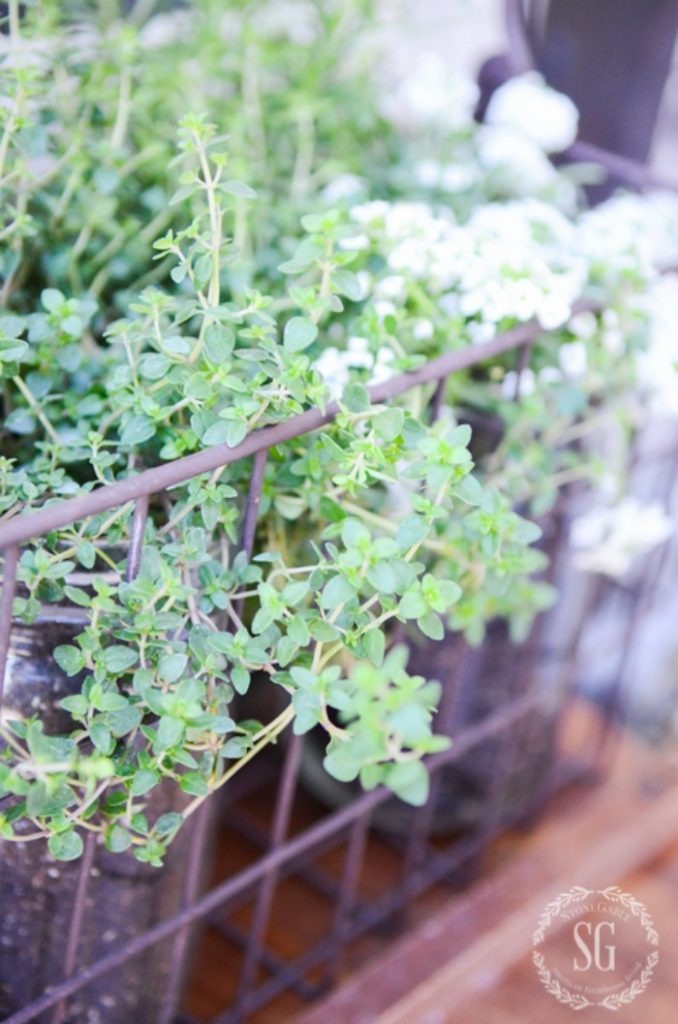
Thyme is a must-have in your container garden.
I love to add whole mature thyme shoots (they are a bit more woody) to sauces, soups, stews, and stock while I am cooking. Tender shoots and leaves are better for finishing a dish.
MAKE ROOM FOR ROSEMARY
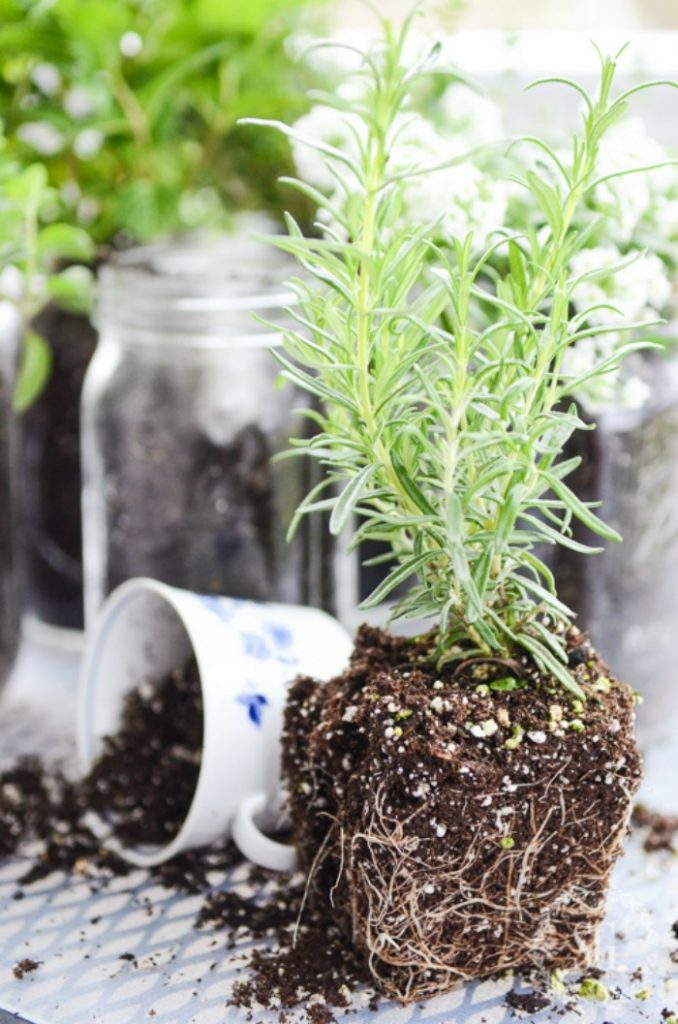
Rosemary is a pungent, aromatic, evergreen herb. Like basil and thyme, it is a member of the mint family. It has needle-like leaves and soft, woody stems.
Rosemary is a very hearty culinary herb! It can grow into huge bushes, and in more temperate climates, it will live from year to year. In my area of Pennsylvania, it usually dies off and comes back in the spring.
Things To Know About Rosemary
One of my favorite uses for a mature rosemary stem is to treat it like a skewer for barbecuing meat.
- Rosemary likes at least 6 hours of sunshine a day. Especially the morning sun!
- It likes water but does not like to be soggy! Let it dry out a bit between waterings.
- Keep cutting rosemary so it does not take over the container garden.
- Rosemary likes good air circulation, so don’t plant tall plants around it. Instead, plant thyme or oregano next to it!
- In the kitchen, rosemary works well with meats. I often add it to butter or oil cooking in a pan so the rosemary can infuse the fat. Oh, yum!
Parsley: A Container Garden Must Have
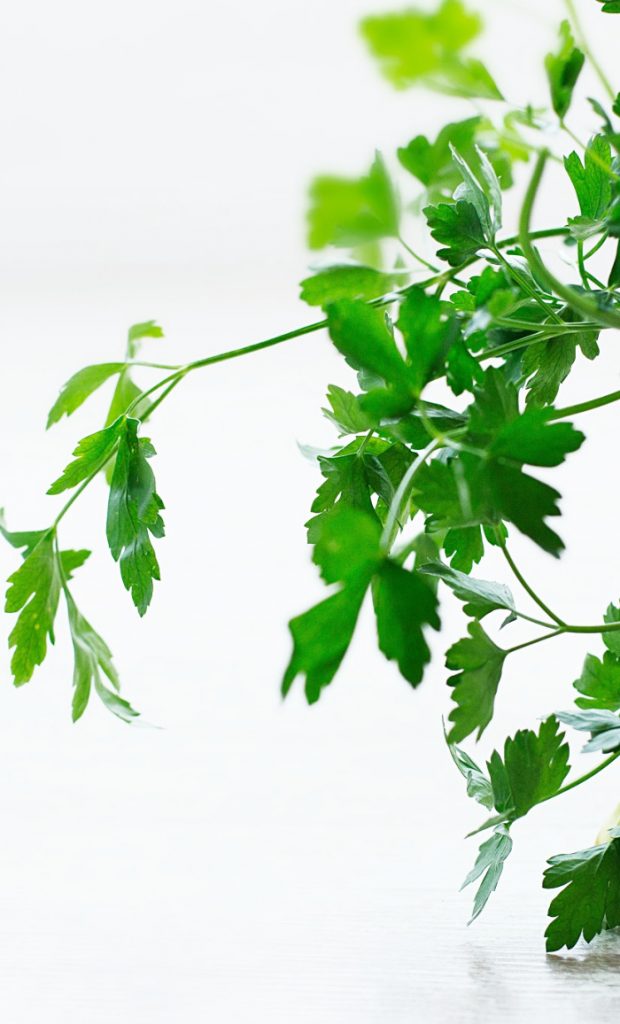
Parsley has a special place in my heart! Although my people originate from about 10 different countries, my Hungarian/Polish roots grow deep. I grew up with the taste of curly parsley and prefer it. However, I grow both in my containers. My grandmother used it in almost every savory thing she made. It grew in her backyard.
So, my grandmother taught me the preciousness of having a bag of homegrown parsley in the freezer, which I can use in soups and stews all winter long!
And having fresh parsley in a container outside my kitchen door is such a convenience! I can cut the parsley, give it a good rinse, chop it, and sprinkle it on a dish to add a bit of freshness.
Things To Know About Parsley
- Parsley likes some sun. Just not sun all day. Like many of these herbs, parsley can handle partial sun.
- Water is a friend to parsley! Keep the ground around it barely moist and never dried out.
- Cut parsley back to encourage new growth.
- One little plant does not go far, so plant several in a container garden! As you use one, replace it with another.
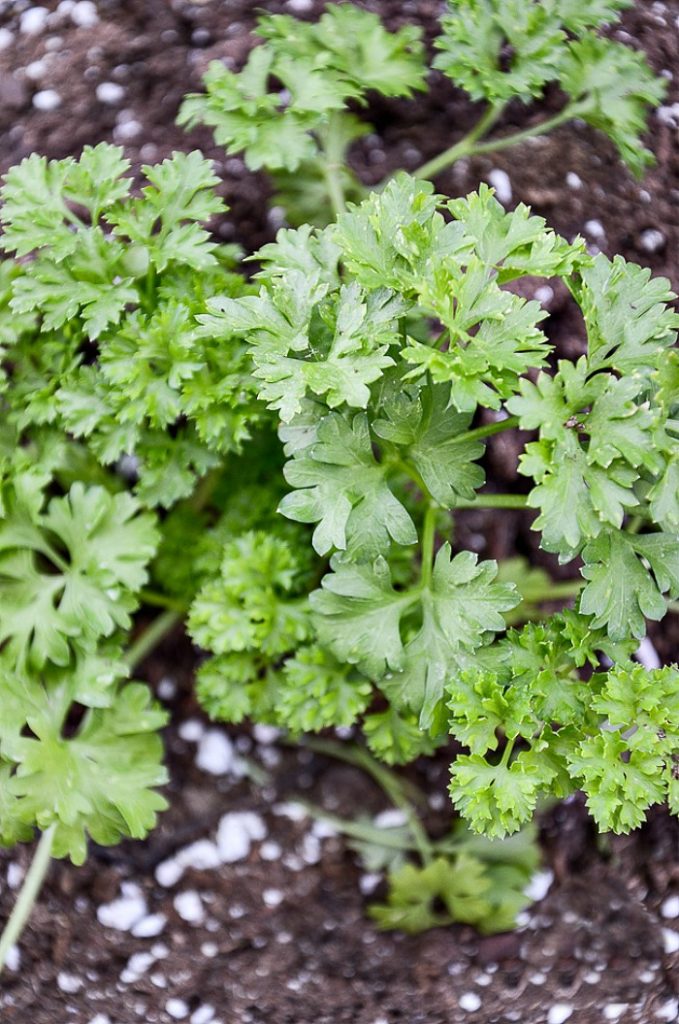
There are three types of parsley, but only two are well-known. French, or curly leaf, Italian or flat leaf, and Hamburg known for its celery-like taste. I plant French and Italian parsley.
Make Room For Oregano
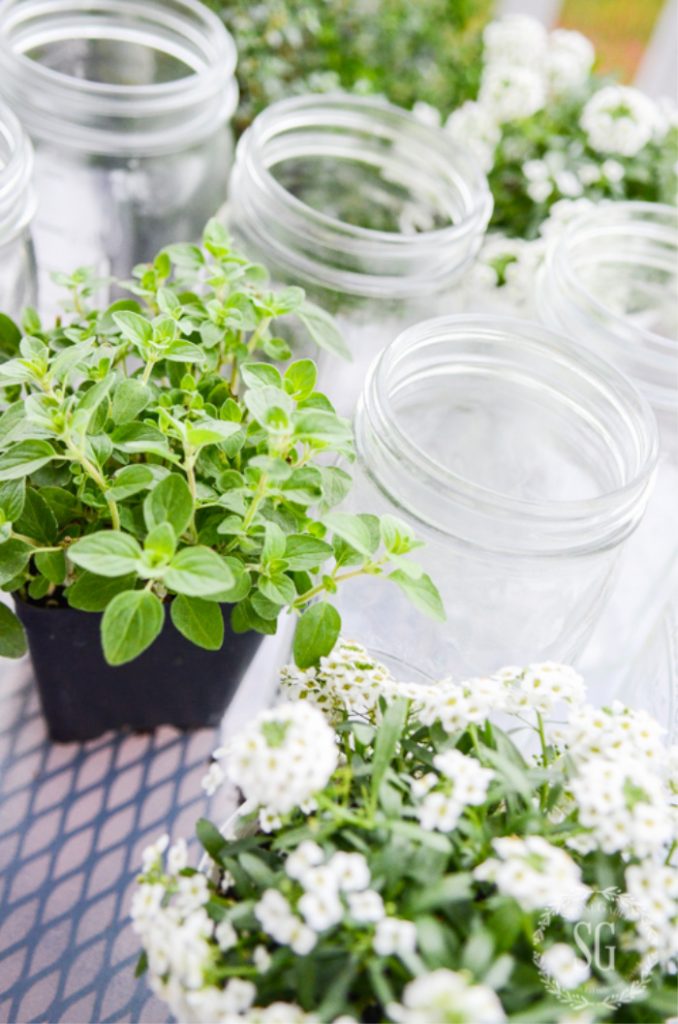
As container garden herbs go, you can’t beat oregano. It is a hardy plant and a prolific grower. It has a robust flavor; I use it in marinades and Italian dishes!
Oregano needs to be pinched back so it does not flower. But to tell the truth, I often let some of my oregano go to flower because the pink flowers are so pretty and edible. They have a more delicate flavor than oregano leaves and make a charming garnish.
Things To Know About Oregano
- Oregano lives well beside other plants.
- Water oregano and then let the soil get a bit dry. So plant them next to other herbs like rosemary that like dryer soil.
- Pinch this plant back often so it does not get leggy.
- Oregano is an herb that dries well. When it is dried, the flavor intensifies.
In the kitchen, fresh oregano can withstand long simmering times, making it perfect for Marinara sauces and other Italian dishes. I like to add a crushed garlic clove and fresh oregano to jarred spaghetti sauce; it gives it a fresh taste!
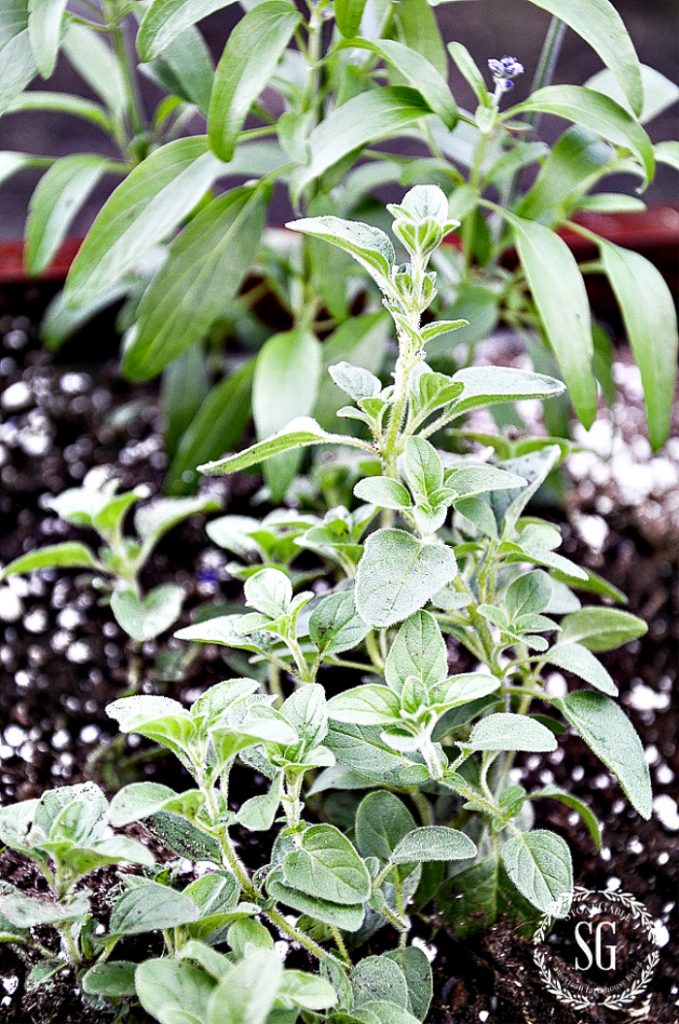
When you are cutting a garden bouquet, remember to add a few sprigs of oregano. It’s such a pretty herb!
Plant Sage
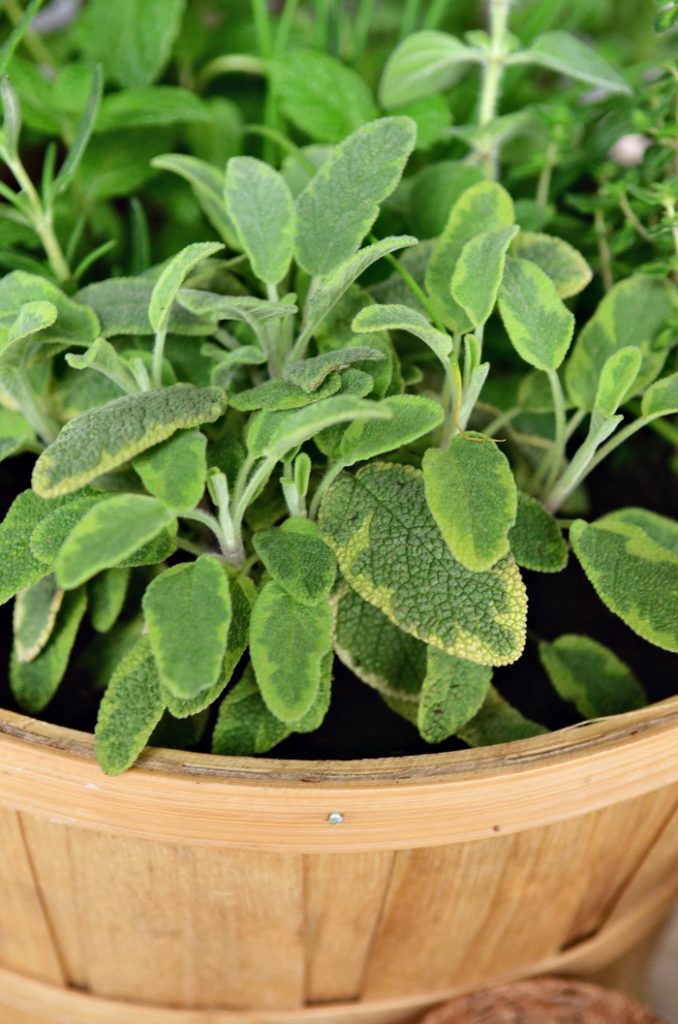
Sage is often forgotten in container gardens. It’s so pretty, and its long, often variegated leaves add such an interesting element to any pot!
Sage is a perennial and is a wonderful addition to many meat and stew dishes.
Like rosemary and oregano, it can withstand long cooking times and helps a stew, marinade, or sauce develop a complex and delicious flavor!
It is best known for the flavoring in Thanksgiving stuffing and scrumptious breakfast sausage. But don’t stop there.
Sage’s warmth will flavor brown butters, bean dishes, egg dishes, tomato sauce, and bread—it is a must in a bouquet garni!
Things To Know About Sage
- Sage is a sturdy, prolific plant!
- It likes medium sun. So the morning sun and filtered sun in the afternoon is perfect!
- Clip it just above where a pair of leaves meet to harvest sage.
- To get the most essential oils that give sage flavor, harvest them in the morning just after the dew has gone.
At the midpoint of the growing season, clip the plant back (and dry the leaves) to promote robust growth for the rest of the season.
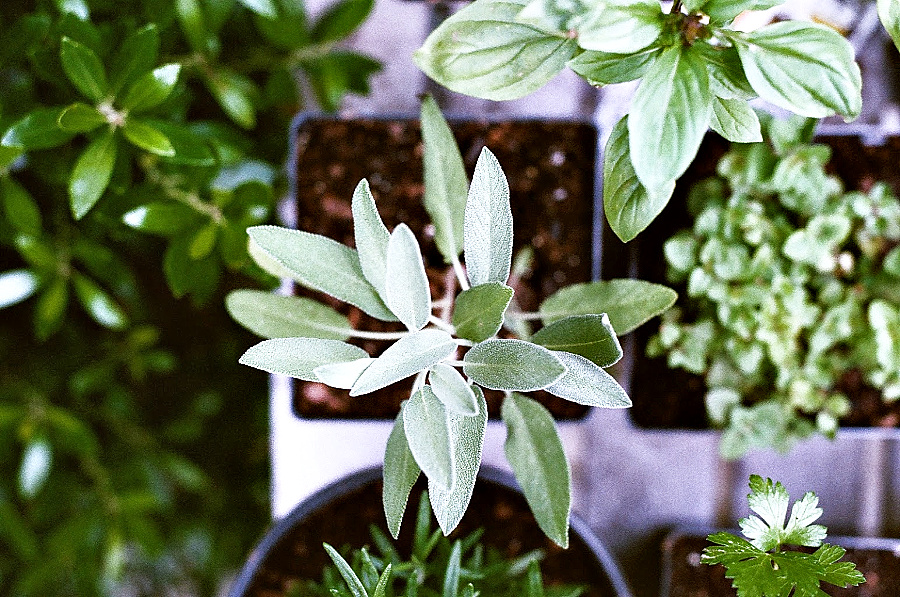
Other Herbs To Grow In A Container
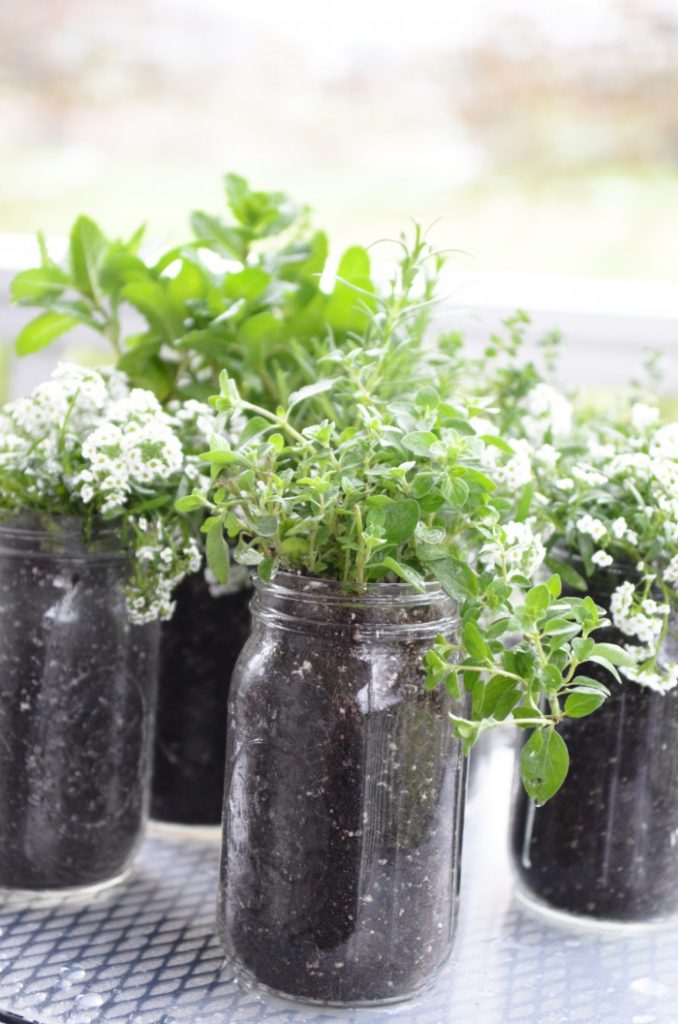
- catnip (plant is separate container, it’s like mint)
- dill (best planted in late spring)
- lemon balm
- marjoram
- tarragon
- cilantro
- bay
- camomile
If this is the first time you are planting an herb container garden or the one hundredth, there is always something new to learn, some magical gift herbs give you, and something to share from your labors with others.
Herbs are the most useful and giving plants! Tending an herb garden is sheer pleasure!
You might also like these other posts about herbs.
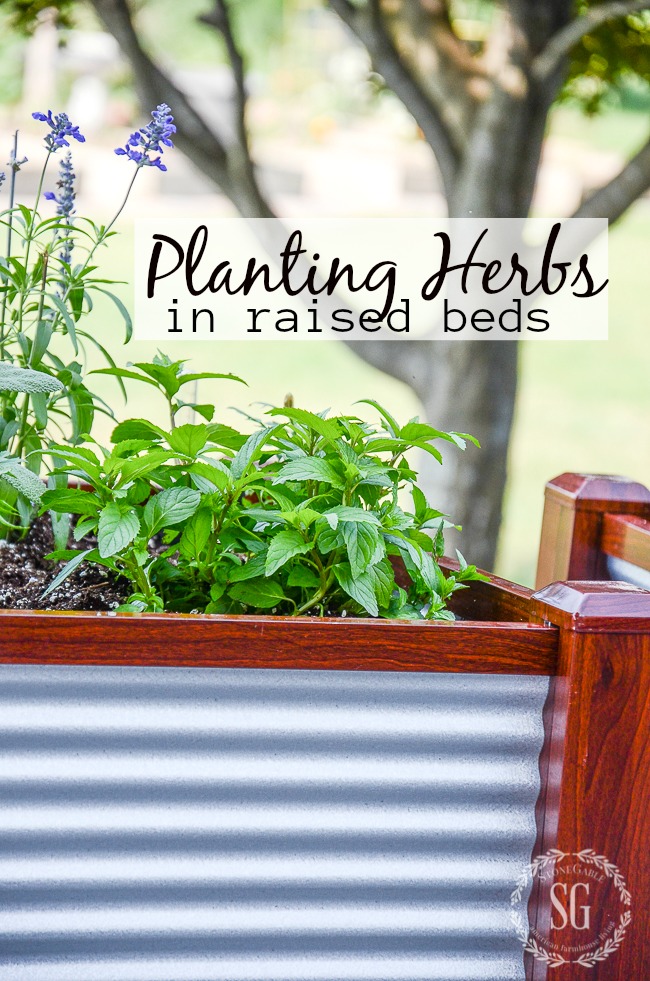
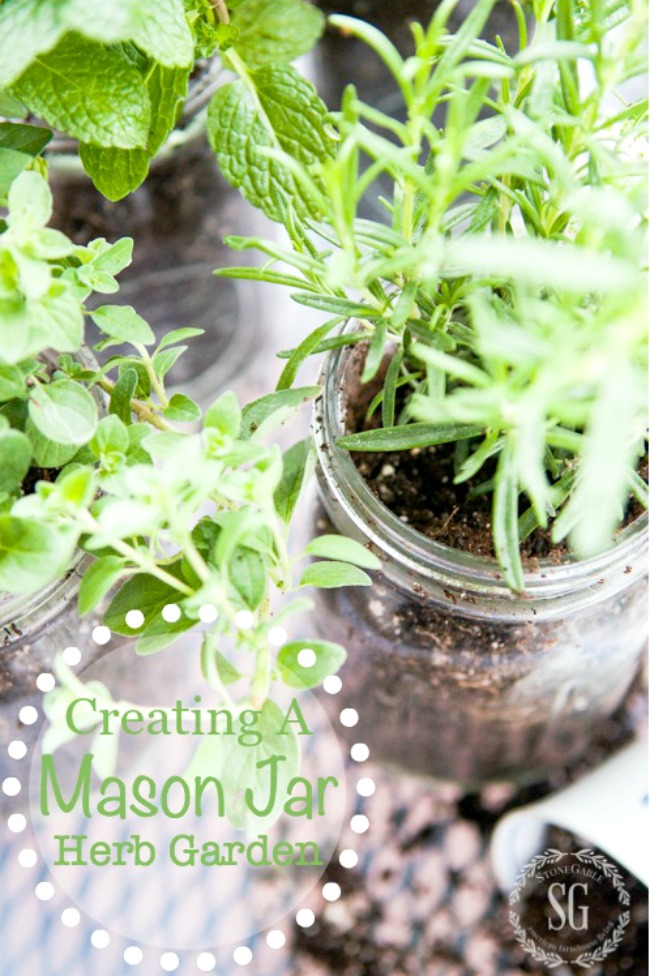
PAINT A PRETTY CONTAINER AND PLANT AN HERB GARDEN
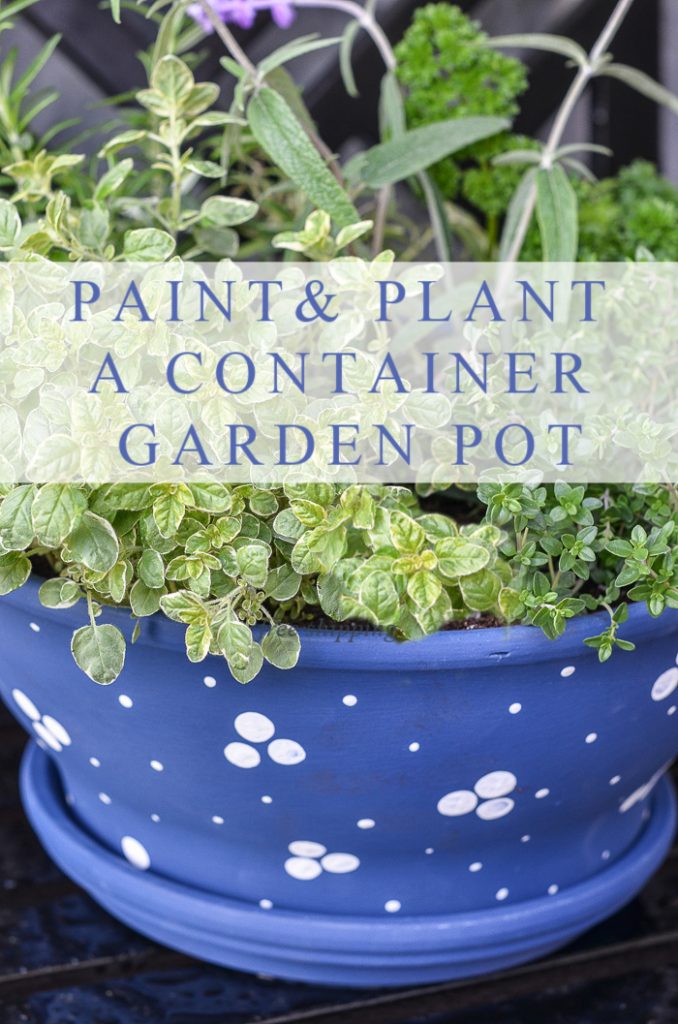
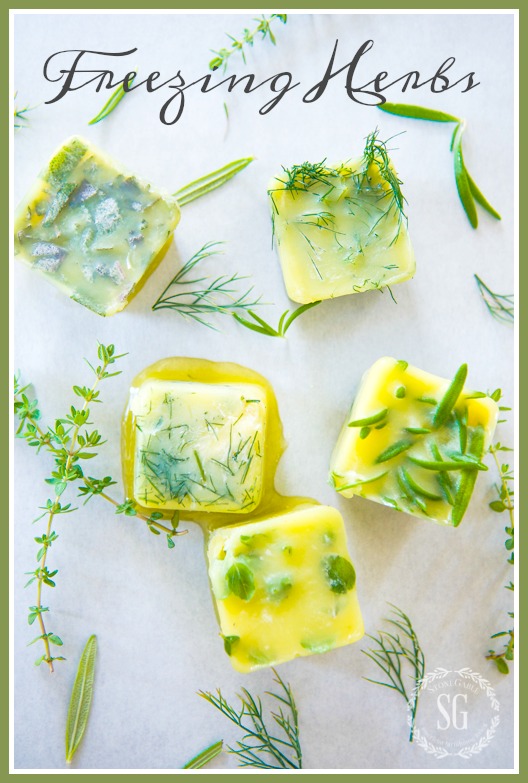
DELICIOUS AND EASY GARDEN HERB SALT

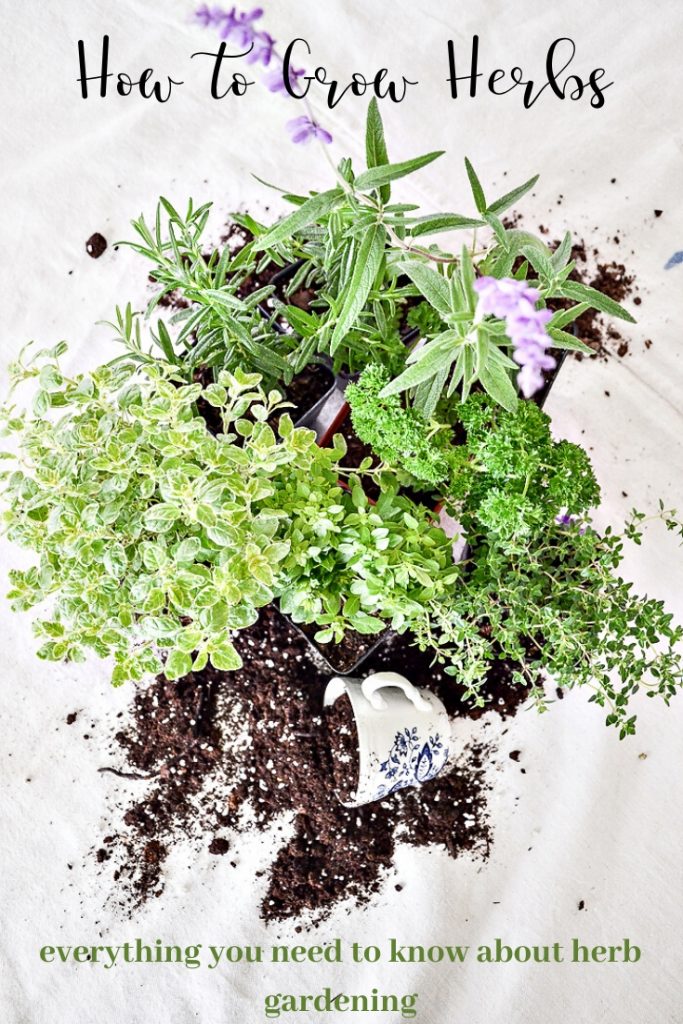
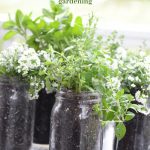
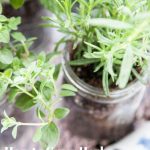
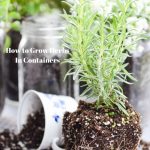
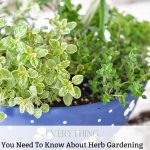
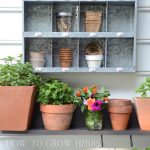
So fun to have an herb garden and they all look so beautiful.Thanks for all the growing tips.
You are so welcome, Doreen!
Wow. This herb issue is wonderful. I had just bought herbs to do a garden. I am like the Grim Reaper of green , so I will refer to this issue often. Ty.❤️
LOL, Marialaina! So funny! Here’s the good news about many herbs… they are easy to grow and don’t need much tending! Happy planting
I love growing Basil but sometimes the bugs get it. I don’t know what kind of bugs but as soon as I see the damage I can’t eat it anymore.I enjoy making pesto too and love to make bruchetta .
Hi Deb, I’ve never heard of bugs in basil before but I’m sure it can happen. Check your soil. Or try companion planting basil and rosemary together. Bugs don’t like rosemary!
Is that lavender with your herbs? So pretty! Heading to the garden store tomorrow to make my own herb garden. Thanks for the tips!
Hi Deb, it’s salvia! I adore salvia. The color is so pretty and it looks nice in garden bouquets.
This post is so helpful. Most of my yard is full sun, so with this helpful information this brown thumb gardener is going to give them a try. I love fresh herbs for cooking, especially in salads.
THanks Leanna! How nice to know you too use fresh herbs in salads!
We just got back from Savannah Ga,our first trip since Covid kept us at home.Beautiful old southern city with great gardens. Came home after a week to find spring had arrived in N.C and that my garden was calling. Herbs were my first love as a gardener and I like to mix them in my flower borders,raised vegetable bedsas well as in containers on my deck. Usually I give each herb it’s own pot and arrange them like one big container. Then if one isn’t doing well I can easily replace it. Also like to add some edible flowers to the mix like nasturtiums, pansies and calendulas. Can’t wait to get shopping at my favorite nurseries and go play in the dirt.
Happy Spring.
LOVE Savannah! You are a gal after my own heart!
Hi Yvonne — Your container Herb Garden Guide was so informative. I am also going to try your recipes for Pesto and Chimichurri Sauce. The Chimichurri recipe has me a bit confused. Should the parsley be chopped before adding it to the other ingredients and if so, how finely should it be chopped? Would this recipe work in a food processor? I always love your posts and learn new ways to think about new ideas all the time. Thank you for bringing all this beauty into the lives of so many! Most Sincerely — Jan
Yes, throw it all in a food processor but pulse it. You don’t want it to become a paste.
Are there any particular herbs you mentioned here that bunnies DO NOT like? I have tried herbs before but the bunnies got to it before me ?♀️ Thank you for all your great ideas !
You might want to consider a tall planter. Then you can have herbs and the bunnies won’t be able to reach them. See one here:https://rstyle.me/+RvTjwegotgVqLC9W3DlmgQ
I’ve really enjoyed this post! I love growing herbs and have learned from this post!!!
I was so inspired by this post. I love vegetables and salads and this year my herb garden has been a joy! The fragrance of fresh basil is the essence of summer. I just gave a house warming gift with fresh rosemary tucked in the bow! I so look forward to your posts. Your enthusiasm is contagious!!
Thanks, Nancy! Basil is the smell of summer to me, as is mint!
Awesome post! We just picked up our flower, veggie and herb plants today, I have 7 herb plants, now I want two more you mentioned that we don’t have! Basil is a must, we love fresh Bruchetta, mdke with our own grown Roma tomatoes and basil. Yvonne you mentioned drying oregano, would you tell me, how you do it please? It is one of the most used herbs in our house and I would love to grow and dry my own. I’m printing out your post, to refer to it, when watering my herbs. Thanks so much!
Hi Elaine, I’m so glad you enjoyed this post. Sounds like your herb garden gets used. I love that! You can naturally dry oregano by tying it in small bundles and hanging them up to air dry. When the bundles are dry crumble the leaves and keep them in an airtight glass container in a dry, dark place. Also, you can wrap the oregano in a paper towel and microwave it on a low setting, 30 seconds at a time until it is dry. Hope this helps. Happy gardening!
I truly appreciate this post, because I found out through you, that some of these plants needs larger pots, because how large and wild they grow. Others ok in smaller pots. As well as what needs more sunlight, whereas some do not . I would have done all of my herbs wrong had it not been for your sweet post. Thank you!
Thank you so much Ivory.
Love this post and the way you organized it and made it easy peasy for us! Thank you! I have always loved growing basil, but inspired to try a few more herbs. We moved to Ohio several months ago where EVERYTHING seems to grow well! Thank you, again!